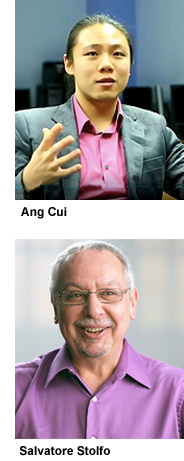Unlocking big genetic data sets
Study coauthored by David Blei and published in Nature Genetics describes using TeraStructure, an algorithm capable of analyzing up to 1 million genomes, to infer ancestral makeup of 10,000 individuals.
Study coauthored by David Blei and published in Nature Genetics describes using TeraStructure, an algorithm capable of analyzing up to 1 million genomes, to infer ancestral makeup of 10,000 individuals.
Floraform, a design system from Nervous System, simulates differentially growing elastic surfaces to craft unique 3D-printed jewelry.
They will build a system to detect outages by monitoring flow of out-of-band data (Twitter feeds, communications networks) so outages can be detected even if grid monitoring system is disabled.

Symbiote technology, which protects printers, routers, phones, and other peripherals from malware attacks, has been named by Popular Science as one of 2016’s “Best of What’s New.” Each year, thousands of new products and innovations are reviewed by magazine editors, with the top 100 winners across 11 categories chosen for inclusion in the “Best of What’s New” issue. Symbiote technology was recognized in the security category.

Symbiote technology grew out of cybersecurity research conducted in Salvatore Stolfo’s Intrusion Detection Systems lab at Columbia University. Ang Cui, then a PhD student (and one-time hacker), was experimenting with different offensive attacks when he found serious security flaws in the firmware of printers, flaws that allowed him to spy on what the printers were printing and to even break into computers connected to the printers. It was a major vulnerability that affected not only printers but almost any other connected device with embedded software, including VoIP phones, routers, network switches, videoconferencing components, and industrial equipment. As more devices and systems connect to the Internet—health monitoring, automobiles—they too become vulnerable to similar attacks
Pivoting from attacking devices to protecting them, Cui and Stolfo created small pieces of code, called symbiotes, that insert into the firmware of a device and continuously monitor for anomalies suggestive of an intrusion. Symbiotes install on any device regardless of the underlying operating systems and require no hardware or source code modification, making it easy to harden existing devices.
Symbiote technology represents 10 years of work and is now being commercialized through Red Balloon Security, a company founded by Ang and Stolfo. Hewlett-Packard announced it would install Symbiote technology on its high-end printer products.
For more about the research behind symbiotes, see Defending Embedded Systems with Software Symbiotes.
Posted: 10/24/2016
– Linda Crane
The site, which harnesses donated genetic test results for scientific research, has new features and is already working with the National Breast Cancer Coalition.
In podcast, Stolfo discusses current and future uses of artificial intelligence to detect security intrusions.
Paper by David Blei, Allison J. B. Chaney, Hanna Wallach, and Matthew Connelly describes using a Bayesian modeling technique to characterize and isolate significant events in 2M US diplomatic cables from the 1970s.
Find open faculty positions here.
President Bollinger announced that Columbia University along with many other academic institutions (sixteen, including all Ivy League universities) filed an amicus brief in the U.S. District Court for the Eastern District of New York challenging the Executive Order regarding immigrants from seven designated countries and refugees. Among other things, the brief asserts that “safety and security concerns can be addressed in a manner that is consistent with the values America has always stood for, including the free flow of ideas and people across borders and the welcoming of immigrants to our universities.”
This recent action provides a moment for us to collectively reflect on our community within Columbia Engineering and the importance of our commitment to maintaining an open and welcoming community for all students, faculty, researchers and administrative staff. As a School of Engineering and Applied Science, we are fortunate to attract students and faculty from diverse backgrounds, from across the country, and from around the world. It is a great benefit to be able to gather engineers and scientists of so many different perspectives and talents – all with a commitment to learning, a focus on pushing the frontiers of knowledge and discovery, and with a passion for translating our work to impact humanity.
I am proud of our community, and wish to take this opportunity to reinforce our collective commitment to maintaining an open and collegial environment. We are fortunate to have the privilege to learn from one another, and to study, work, and live together in such a dynamic and vibrant place as Columbia.
Sincerely,
Mary C. Boyce
Dean of Engineering
Morris A. and Alma Schapiro Professor